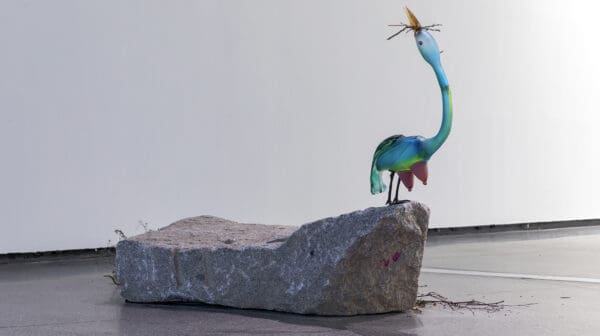
Laure Prouvost meets the real with the ludicrous
French-born/Belgium-based Laure Prouvost animates her first major Australian survey with her hallmark absurdism. ‘Oui Move In You’ is showing now at the Australian Centre for Contemporary Art.
I like seeing artists win prizes. Mostly, I just like seeing artists get paid. The richest prizes, they’re a year’s salary. They’re a chance to make something ambitious, or travel, or study, or just pay the rent. They’re breathing room. But most artists don’t enter expecting to win.
When Sydney-based curator Sebastian Goldspink spoke to ArtsHub recently about what it’s like judging art prizes, he was enthusiastic about all the connections he’d made, including with artists who hadn’t been shortlisted. “I’m often called upon by other curators to recommend artists for projects,” he explained. “Many of these artists come directly through the judging process.”
That’s the dream. Anyone can enter a prize. Anyone can have their work seen and perhaps rewarded, whether that’s through a prize or exhibition opportunity, or the more nebulous processes that Goldspink is referring to.
Prizes can also be a form of motivation. Or they were for me as a writer when I started entering short story competitions a few years ago. Prizes offered deadlines, and forced me to finish projects instead of starting more new notes in my phone. They were a way to take those first steps.
For visual artists who have already made a name for themselves, prizes can also be a way to remain visible when they don’t have gallery representation, or can’t put up a solo exhibition every 12 to 24 months. Day jobs. Family. Health. There are any number of reasons why the pace of the art world might feel demanding. Entering a single work into a prize can be a little flash of light: “Hey, I’m still here. I’m still working.”
However much of a luxury it might be, ‘momentum’ is one of those ideas that’s baked into the art world. There are now international data firms that make it their business to track not just artists’ career milestones—prizes, institutional shows and so on—but how quickly they are achieved. Whether prizes are analysed in such cold terms as this, or just entered as a line item in a CV, they remain one of the ways that intangible concepts like ‘momentum’ and ‘critical attention’ are quantified, ready for conversion into other forms of capital.
This is a hard one for me to talk about. Prizes have meant so many things in my life. Encouragement. Money. The chance to have my work read. (Nobody owes you their time etc etc.) Unexpectedly, they’ve also helped my art writing. I’m more confident. So to call those first stumbling steps an attempt to create capital? Who would ever see themselves like that?
Looking back, I’m also not sure I would’ve bothered to enter prizes but for how easy it was. Journals had erratic submission windows. Prizes didn’t. There were also a lot more of them. Not to push the comparison, but I think it’s broadly true of the art world too. Prizes can seem like a much more transparent, accessible and coherent process than, say, getting in front of a dealer, and much faster than applying for a grant. And this is the question I keep circling: What do prizes say about the paths available to artists to move into and maintain a professional practice?
Prize organisers have their own varied motivations. Some prizes are exercises in local programming and community building. Acquisitive prizes can be used to build specialist collections, such as Shepparton Art Museum’s Indigenous Ceramics Award. In real terms, they help institutions shape their identities, support their communities and establish and expand their art collections.
Corporates also use prizes as marketing campaigns. Telstra has supported the National Aboriginal and Torres Strait Islander Art Awards for over three decades. This year, it contributed $190,000 in prize monies and provided The Museum and Art Gallery of the Northern Territory with a further $50,000 acquisition fund. (Telstra’s revenue last financial year was $21.5 billion.) Others, like the Bulgari Art Award, which ran from 2012 to 2017, haven’t lasted quite as long. The Art Gallery of New South Wales now hosts a new and different prize, the La Prairie Art Award.
Other prizes are backed by artists, such as the Rick Amor Self Portrait Prize at Montsalvat, or private patrons or foundations, like the acquisitive Josephine Ulrick and Win Schubert Photography Award at Home of the Arts, founded two decades ago at a time when photography was blithely considered an ‘entry point’ into the arts. Prizes offering travel, study or residencies also feel like attempts to fill gaps in the art world ecosystem. Wikipedia lists almost 50 Australian awards, but this is a conservative edit. The gamut of smaller, local and regional prizes probably puts this number in the hundreds, which all raises the question, what should a healthy art world even look like?
There is of course another, more obvious reason for prizes. The Art Gallery of New South Wales’s Archibald, Wynne and Sulman prizes survive because they are so well loved by the general public. These big draw cards remain the template. Prizes are events, news pegs and measures of the zeitgeist. They are one of the few times art breaks into the mainstream news cycle. And, well, they’re prizes. They feel good. (Provided your art-nemesis hasn’t won.)
All artists, whether they enter prizes or not, must ultimately develop their own philosophy on the “success and the not-success”, as Lindy Lee once called it. So, are prizes worth it? Well, that depends. It might be more interesting to ask if and how prizes help build the dream of a level playing field, what they promise, and what cracks they might be masking.